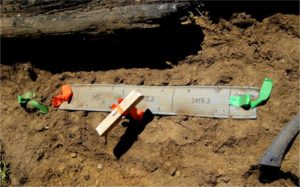2013 WBP Trials to Test for Optimum Sowing Dates & Planting Depths
Project: WBP Trials to test for optimum Sowing Dates and Planting Depths for seed and compare with two seedling container sizes
Agency/Forest or Park/District: Thompson Peak, Lolo National Forest. Gold Pass, Idaho Panhandle National Forest
Project coordinator: Terrie Jain

Contact: Terrie Jain, USDA-FS RMRS, Moscow, ID. tjain@fs.fed.us
Cooperators
Terrie Jain, RMRS, Moscow; Cathey Hardin, Caribou-Targhee NF; Elizabeth (Liz) Davy, Caribou-Targhee NF; Karl Buermeyer, Bridger-Teton NF; Valerie Walker and John Waverek, Lolo NF; Sidnee Dittman, St. Joe NF; Dan Reinhart, Yellowstone National Park; Kevin Egan and Nathan Robertson, Coeur d’Alene Nursery.
Source of funding /amount
FHP: $4,990
Supplemental funding: $8,080 from Forest, Nursery, FHP and RMRS.
Dates of restoration efforts
Summer 2013- Fall 2015
Objectives
Improve cost efficiency and increase potential attainable acreages of projects for restoring whitebark pine (Pinus albicaulis) across its range by optimizing direct-seeding vs. seedling techniques for accomplishing regeneration
Determine planting window for operational field-sowing of seeds
Determine optimum seed planting depths for field planting dates and sites
Determine whether non-pretreated vs. warm-stratified seed are preferable for extended (non-fall) field-sowing
Compare direct seeding vs. fall-planted seedlings from 10 vs. 7 in3 tubes
Acres/ha treated
Treatments scattered across 5-10 acres per site
Methods
The proposed study will test seed depths and seed pre-treatments appropriate to different planting dates, and compare with fall-planted seedlings in standard 10 in3 vs. “stubby” 7 in3 Leach cells (the latter provide a shorter root plug that may be more appropriate for planting in shallow, rocky soils).
Previous fall-seeding tests at 1.5” depth compared four seed pre-treatments: warm stratification, scarification, both treatments, and control (Schwandt and DeMastus 2011; Schwandt et al 2010). Preliminary results showed that warm-stratification enhances germination of fall-sown seed, especially the first year, whereas non-pretreated (control) seed germinated over 2-3 seasons. Also, finding fully-developed germinants among seed that did not emerge suggests a need to test if seed depth needs optimization, both for fall planting, and for other potential planting dates.
Three planting dates (end of July, end of August, end of September) and 2 planting depths (0.75 and the 1.5 inches previously used) will be tested. The best treatment for fall-sowing (warm stratification) will be tested against untreated (“dormant”) control seed that may offer an advantage when planted in summer. Design will be to establish essentially “paired-treatment” tests of single seeds / seedlings for all treatments, at 50 microsites (e.g., logs, etc.) per installation site. Weather instruments will be installed at each site to monitor and record temperatures at the soil surface and at the two planting depths. Microsite data (soil, protection type, convex vs. concave surface topography, slope, aspect, log orientation, previous fire, proximal herbaceous layer, soil bio-crusts) will also be recorded.
Seed will be from seed lots appropriate to the localities. Seed requirements per installation are 200 x 3 planting dates = 600 for direct seeding, plus 100-200 per seed lot for germination tests.
Planting? If so, source of seedlings? Resistance?
Planted seedlings from local sources that are stored at the Coeur d’Alene nursery. Resistence is unknown because they are not screened for resistance. 100 seedlings were planted at each site; 2 next to each of the 50 direct seeding replications at each site.
Location: Center of replications at Gold Pass: 47.230625 -115.313712
At Thompsen Peak: 47.747779 -114843439
Outcome
Completed installation of plots at 2 sites – planted seeds on 3 different dates as planned and also planted seedlings at each site for comparison.
For each field location, we established 50 replications of direct seeding to compare 2 seed treatments, 2 planting depths and 3 different planting dates. We optimized field protocols for installations and developed planting jigs and portable templates to accurately deliver seed at the two pre-defined soil depths at 12 sites per replication.
Each rep. had 12 seeds for a total of 600 seeds per location.
We also selected or constructed mircrosites that differed in ability to catch and hold locally available water such as by concave, flat, and convex ground surface, plus three soil surface types: char, duff and mineral soil.
Monitoring since completion of the project
Dates Spring and Fall 2014 & 2015: Collect germination and temperature data
Plans for future monitoring? Yes – we plan for a minimum of 2 years of monitoring (twice per year) of germination and survival of germinants – which will take approximately 4 days per year.
Will outcome meet goals?
We expect it will – future monitoring will document any differences. First germination monitoring will commence in summer 2014.
Future actions/follow up?
Future actions are to monitor each site for a minimum of 6 to 10 years as opportunity arises or if funding is available. Growth will also be monitored to determine if restoration objectives are being met.
Miscellaneous comments
We dropped the comparison of two different sized seedlings due to unavailability of seedlings of both sizes. We also were unable to install plots at Gisborne due to NEPA process for Research Natural Areas (a prescribed burn was proposed to provide a comparison of burned and unburned sites) but plan to propose adding this site in 2 years after NEPA and prescribed burns are expected to be complete.